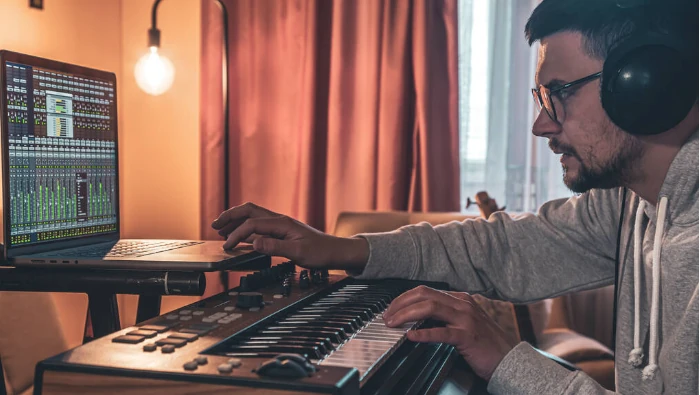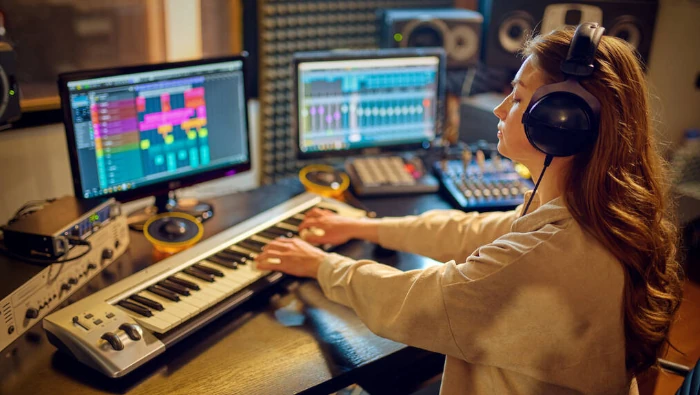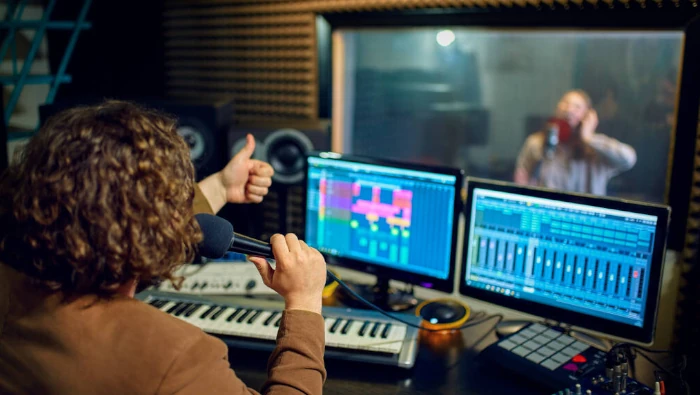Have you ever felt a surge of melodies and harmonies coursing through your mind, yearning to break free and resonate through speakers around the world? The journey from mental symphony to audible reality has long seemed a daunting path, reserved for the musically gifted or the technologically adept. Yet, in this era of digital innovation, the doors to musical creation have swung wide open, welcoming all who dare to explore their inner composer. Thanks to pioneering software like Sonar, the art of crafting your own musical arrangements is not just a possibility—it’s an accessible adventure for anyone with a passion for music.
Imagine the thrill of blending chords, rhythms, and instruments to tell a story, evoke an emotion, or simply set a mood. This isn’t just about pressing keys or strumming strings; it’s about letting your unique musical voice be heard. But here arises an intriguing question that might tickle your curiosity: How long does it truly take to transform a spark of creativity into a complete musical arrangement? The answer may surprise you and inspire you to embark on your own musical quest.
As we dive into the world of musical arrangements, we invite you to keep an open mind and a ready heart. Whether you’re a budding music composer, a hobbyist looking to expand your skills, or even a seasoned arranger curious about fast-tracking your process, this guide promises to enlighten, engage, and elevate your musical journey. So, let’s set the stage, tune our instruments (or software, as it may be), and discover how to unleash the full potential of your inner composer in just 2 hours. The journey begins now, and the world eagerly awaits the music only you can make.
Understanding the Arrangement Process
Diving into the heart of music creation, the arrangement process is where raw melodies and chord progressions transform into a full-fledged musical masterpiece. It’s akin to an artist choosing the right palette of colors to bring a canvas to life, where every shade and stroke contributes to the overall vision. For those stepping into the realm of musical arrangements, understanding this process is both fascinating and foundational.
Creativity Meets Technique
At the core of music arrangement is a marriage between creativity and technical skill. Imagine yourself as a musical architect, where your blueprint is the original melody or theme. Your task is not just to build upon it but to enhance it, shape it, and sometimes, completely reimagine it. This creative endeavor requires you to listen, not just with your ears, but with your heart and mind, envisioning the infinite possibilities that lie within a single tune.
The Composer vs. The Arranger
While a music composer births the initial melody, the arranger breathes life into it, giving it texture, dynamics, and context. Think of composing as writing a beautiful story, and arranging as deciding how it’s told, what voices to use, and how to pace the narrative. A music composer might dream up a melody that whispers in the wind, but it’s the arranger who decides whether that whisper becomes a storm or a symphony.
Beyond the Notes
For arrangers, the journey extends beyond mere notes on a page. It’s about understanding the essence of the song and its potential forms. Whether you’re working in a home studio or a professional setting, the goal is to tap into the song’s soul and dress it in the right musical garments. This requires not just a keen ear for music but an empathetic understanding of what the composer or client envisions for the piece.
Arrangement is your opportunity to infuse a piece of music with your own creativity and insight, making it resonate more deeply with listeners. As you step into this role, remember that your decisions—whether they pertain to instrument selection, harmony layers, or rhythm adjustments—can turn a simple melody into an unforgettable experience for your audience.
In essence, the arrangement process is your canvas, and you are the artist. With every decision, you’re not just crafting a song; you’re shaping emotions and creating moments that can last a lifetime. As we peel back the layers of this intricate process, let’s embrace the beauty of transformation that lies at the heart of music arrangement. It’s not just about what you add or change; it’s about how you listen, interpret, and ultimately, how you tell the story that’s waiting to be told through music.
Meeting Your Client: The Initial Steps

The journey of musical arrangement often begins with a simple yet profound interaction: meeting your client. This initial meeting is not just a transaction; it’s the first note in the symphony of collaboration. Whether they’re an aspiring artist, a seasoned musician, or a band on the brink of their breakthrough, each client brings a unique melody and vision to your studio. Understanding and capturing this essence is crucial to the success of the arrangement process.
The Art of Listening
As your client unveils their song, perhaps strumming a guitar or humming a tune, your primary tool is not the software or instrument—it’s your ability to listen. This listening goes beyond the surface, delving into the emotions, stories, and aspirations behind the music. It’s about hearing not only what’s played but also what’s unsaid—what the song could become with the right arrangement. Encourage your clients to share their inspirations, goals, and any specific ideas they have for the arrangement. This dialogue is the foundation upon which you’ll build your collaborative masterpiece.
Capturing the Moment
In these initial moments, it’s essential to capture the raw essence of the song as presented by the client. Recording the performance, even in its most rudimentary form, ensures that you have a reference point as you begin the arrangement process. This recording serves as a tangible reminder of the song’s origin, helping to guide your arrangement decisions and keep the client’s vision at the forefront.
Equally important is gathering any additional materials your client can provide. Lyrics, chord progressions, TABs for specific riffs—these pieces are the puzzle pieces you’ll assemble in the arrangement. They offer insight into the song’s structure and emotional peaks, acting as a roadmap as you navigate the creative process.
Setting the Stage for Collaboration
Once you have a thorough understanding of the song and your client’s expectations, the real work begins. This stage is not just about applying your technical skills but also about maintaining an open line of communication with your client. Discuss potential directions for the arrangement, considering their input while also offering your professional insight into what might elevate the song. Whether it’s suggesting a string section to add depth or a change in tempo to enhance emotional impact, your expertise can transform their vision into a reality.
The initial meeting with your client sets the tone for the entire arrangement process. It’s an opportunity to establish trust, align visions, and embark on a creative journey together. By listening attentively, capturing the essence of the song, and fostering an environment of collaboration, you’re not just arranging a piece of music—you’re helping to bring a dream to life. As you move forward, keep the lines of communication open, ensuring that the final arrangement not only meets but exceeds your client’s expectations.
The Two-Hour Challenge: A Step-by-Step Guide

Embarking on the task of creating a musical arrangement in just two hours might sound daunting, but with the right approach, it’s not only achievable—it can be an exhilarating challenge. This condensed timeframe forces you to focus, prioritize, and unleash your creativity in a way that’s both efficient and effective. Here’s a step-by-step guide to navigating this creative sprint, from initial inspiration to final notes.
Step 1: Setting the Scene
Before diving into the arrangement, take a moment to prepare your workspace and mindset. Ensure your studio, whether at home or elsewhere, is free from distractions. A clear space fosters a clear mind, essential for creativity to flow. Hydrate, take a deep breath, and enter a state of relaxed focus. This mental preparation sets the tone for the intense yet rewarding work ahead.
Step 2: Embracing the Tools
With Sonar software or your chosen digital audio workstation (DAW) at the ready, familiarize yourself quickly with the tools you’ll be using. MIDI sequencing and Soundfonts are your allies here, allowing you to experiment with different sounds and arrangements without the time-consuming process of live recording each instrument. Remember, the goal is to bring the song to life, not to get bogged down by technicalities.
Step 3: The Foundation
Begin by laying down the basic structure of the song. If you’ve recorded a reference with your client, use it as your guiding track. Start with the drums or rhythm section, as they will serve as the backbone of your arrangement. This foundation will keep you anchored as you add more layers.
Step 4: Adding Color and Texture
With the rhythm in place, start adding the harmonic elements. Chords, bass lines, and any key riffs or motifs come next. These elements add depth and emotion to the arrangement. Use MIDI samples wisely here; they can save time and add variety. Be mindful of the song’s dynamics, building up where the emotion peaks and pulling back in quieter moments.
Step 5: The Melodic Elements
Now it’s time to weave in the melody. Whether it’s a vocal line or a lead instrument, ensure it sits well with the arrangement, standing out without overpowering the other elements. This step requires a delicate balance, as the melody is often the song’s most memorable part.
Step 6: Refinement and Review
With all elements in place, take a step back and listen. Adjust levels, pan instruments for spatial effect, and make any necessary tweaks to ensure the arrangement coheres as a whole. This is also the time to quantize, if needed, to tighten up the timing. Your goal is to create a polished, unified piece that aligns with the original vision.
Final Touches
As the two-hour mark approaches, give your arrangement one last review. Ensure it reflects the song’s intended emotion and energy, making any final adjustments. Then, render or bounce the track, ready for feedback from your client or for your own critical listening.
The two-hour challenge is more than a test of speed; it’s an exercise in focus, creativity, and technical skill. By following these steps, you’ll not only develop a working arrangement in record time but also hone your ability to make quick, impactful musical decisions. Remember, the essence of this challenge lies not in perfection but in capturing the spirit of the song within a limited timeframe. Embrace the process, learn from it, and let it inspire your future musical endeavors.
Utilizing MIDI Samples and Sequencing Techniques

In the whirlwind journey of creating musical arrangements, MIDI samples and sequencing techniques stand out as pivotal tools, especially when pressed for time. These powerful resources can significantly streamline the arrangement process, offering both flexibility and efficiency. Here’s how to leverage these tools effectively, ensuring your musical visions come to life swiftly without compromising quality.
Harnessing the Power of MIDI Samples
MIDI samples are essentially pre-recorded snippets of digital music that can be easily manipulated and integrated into your arrangements. They are a treasure trove for arrangers under a time crunch, providing a quick way to incorporate complex instrumentations and rhythms without starting from scratch.
1. Selection: Begin by choosing MIDI samples that closely align with your song’s genre and mood. This ensures consistency in your arrangement and saves time on adjustments.
2. Customization: One of the greatest strengths of MIDI is its adaptability. Don’t hesitate to modify the samples—change the tempo, pitch, or instrumentation to fit the song’s needs. This customization can make a generic sample uniquely yours.
3. Layering: Use MIDI samples not just for the main elements but also for adding layers of complexity. Background strings, atmospheric pads, or rhythmic percussions can all elevate your arrangement, creating a richer sound palette.
Mastering Sequencing Techniques
Sequencing is the process of arranging your MIDI samples and recorded parts in a digital audio workstation (DAW). It’s where the magic of bringing individual pieces together to form a cohesive whole happens.
1. Structural Layout: Start by laying out the song structure in your DAW—verse, chorus, bridge, etc. This visual framework helps you place your samples and recordings accurately, ensuring a smooth flow.
2. Dynamic Variation: Use sequencing to build dynamics into your arrangement. Introduce variations in volume, panning, and effects across different sections to maintain listener interest and convey emotion.
3. Efficiency Through Repetition: Don’t shy away from copying and pasting parts where repetition occurs. This not only saves time but also ensures consistency in recurring motifs or rhythms.
Practical Tips for Using MIDI and Sequencing
– Drums First: Begin with sequencing the drum tracks. A solid rhythmic foundation makes it easier to align other elements harmoniously.
– Chordal and Melodic Elements: After the drums, add chord progressions and melodies. This layered approach helps in balancing the mix as you go.
– Quantization with Care: Quantization can tighten up timing discrepancies, but use it judiciously to avoid losing the human feel, especially in genres that thrive on groove and swing.
Conclusion
Utilizing MIDI samples and mastering sequencing techniques are invaluable skills in the arsenal of a modern arranger. They not only facilitate a rapid arrangement process but also open up endless creative possibilities. By following these guidelines, you can transform your musical ideas into fully realized arrangements with efficiency and flair. Remember, the ultimate goal is to serve the song, enhancing its emotional impact and connective power. With these tools at your disposal, you’re well-equipped to do just that, even within the most pressing deadlines.
Conclusion: The Path Forward

As we draw the curtain on our journey through the exhilarating process of creating musical arrangements in just two hours, it’s important to step back and reflect on the path we’ve traversed. From understanding the initial nuances of meeting your client and capturing their vision, to diving deep into the creative essence of arrangement, and harnessing the power of MIDI samples and sequencing techniques, we’ve covered substantial ground. This journey, though outlined in steps and tips, is far more than a methodical process—it’s an invitation to explore, innovate, and express.
Embracing the Challenge
The two-hour challenge, while a practical timeframe for crafting arrangements, is also a metaphor for the broader challenge of music creation itself. It teaches us to embrace constraints as catalysts for creativity, to make decisions with conviction, and to trust in our ability to convey emotion and narrative through music. As you move forward, let this challenge inspire you to push boundaries, explore new horizons, and refine your craft with every arrangement you undertake.
Continuous Learning and Collaboration
The art of musical arrangement is a lifelong journey of learning and growth. Each project brings its unique challenges and opportunities for discovery. Stay open to new ideas, technologies, and collaborations. Engage with other musicians and arrangers, sharing insights and drawing inspiration from the vast tapestry of musical expression that surrounds us. Remember, every arrangement is a collaboration, not just with the client or the composer, but with the music itself, in a shared quest to unlock its fullest potential.
Looking Ahead
As you forge ahead in your musical endeavors, carry with you the lessons and insights from this guide. But also, remember to infuse your work with your unique voice and vision. The techniques and strategies discussed here are not just tools but starting points for your creative exploration. The true magic of musical arrangement lies in the personal touch you bring to each piece, transforming notes and rhythms into stories and emotions that resonate.
A Final Note of Encouragement
To all aspiring arrangers, composers, and music enthusiasts stepping into the world of musical arrangement, know that your voice is a valuable addition to the chorus of creativity that defines our shared musical landscape. Embrace each challenge with enthusiasm, each setback with resilience, and each success with humility. The path forward is rich with possibility, waiting for your unique contributions.
Thank you for joining this journey through the art and science of musical arrangement. Here’s to the music you’ll create, the stories you’ll tell, and the hearts you’ll touch along the way. The stage is set, the instruments tuned, and the world eager to hear the melodies and harmonies only you can bring to life. Let the music begin.

